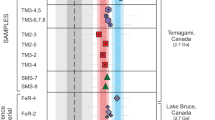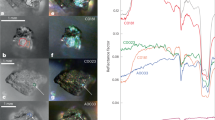Abstract
It has been thought that the lunar highland crust was formed by the crystallization and floatation of plagioclase from a global magma ocean1,2, although the actual generation mechanisms are still debated2,3. The composition of the lunar highland crust is therefore important for understanding the formation of such a magma ocean and the subsequent evolution of the Moon. The Multiband Imager4 on the Selenological and Engineering Explorer (SELENE)5 has a high spatial resolution of optimized spectral coverage, which should allow a clear view of the composition of the lunar crust. Here we report the global distribution of rocks of high plagioclase abundance (approaching 100 vol.%), using an unambiguous plagioclase absorption band recorded by the SELENE Multiband Imager. If the upper crust indeed consists of nearly 100 vol.% plagioclase, this is significantly higher than previous estimates of 82–92 vol.% (refs 2, 6, 7), providing a valuable constraint on models of lunar magma ocean evolution.
This is a preview of subscription content, access via your institution
Access options
Subscribe to this journal
Receive 51 print issues and online access
$199.00 per year
only $3.90 per issue
Buy this article
- Purchase on Springer Link
- Instant access to full article PDF
Prices may be subject to local taxes which are calculated during checkout




Similar content being viewed by others
References
Taylor, S. R. Planetary Science: A Lunar Perspective (Lunar and Planetary Institute, 1982)
Warren, P. H. Lunar anorthosites and the magma-ocean plagioclase-flotation hypotheses: importance of FeO enrichment in the parent magma. Am. Mineral. 75, 46–58 (1990)
Longhi, J. A new view of lunar ferroan anorthosites: postmagma ocean petrogenesis. J. Geophys. Res. 108 10.1029/2002JE001941 (2003)
Ohtake, M. et al. Performance and scientific objectives of the SELENE (KAGUYA) Multiband Imager. Earth Planets Space 60, 257–264 (2008)
Kato, M., Sasaki, S., Tanaka, K., Iijima, Y. & Takizawa, Y. The Japanese lunar mission SELENE: science goals and present status. Adv. Space Res. 42, 294–300 (2008)
Tompkins, S. & Pieters, C. M. Mineralogy of the lunar crust: results from Clementine. Meteorit. Planet. Sci. 34, 25–41 (1999)
Wieczorek, M. A. et al. in New Views of the Moon (eds Jolliff, B. L. et al.) Vol. 60, Ch. 3 221–343 (The Mineralogical Society of America, 2006)
Korotev, R. L., Jolliff, B. L., Zeigler, R. A., Gillis, J. J. & Haskin, L. A. Feldspathic lunar meteorites and their implications for compositional remote sensing of the lunar surface and the composition of the lunar crust. Geochim. Cosmochim. Acta 67, 4895–4923 (2003)
Takeda, H. et al. Magnesian anorthosites and a deep crustal rock from the farside crust of the moon. Earth Planet. Sci. Lett. 247, 171–184 (2006)
Clark, P. E. & Adler, I. Utilization of independent solar flux measurements to eliminate non-geochemical variation in X-ray fluorescence data. Proc. Lunar Planet. Sci. Conf. IX, 3029–3036 (1978)
Lawrence, D. J. et al. Thorium abundances on the lunar surface. J. Geophys. Res. E 105, 20307–20331 (1999)
Jolliff, B. L., Gillis, J. J., Haskin, L. A., Korotev, R. L. & Wieczorek, M. A. Major lunar crustal terranes: surface expressions and crust-mantle origins. J. Geophys. Res. E 105, 4197–4216 (2000)
Hawke, B. R. et al. Distribution and modes of occurrence of lunar anorthosite. J. Geophys. Res. E 108 10.1029/2002JE001890 (2003)
Lucey, P. G. et al. in New Views of the Moon (eds Jolliff, B. L. et al.) Vol. 60, Ch. 2 83–220 (The Mineralogical Society of America, 2006)
Adams, J. B. & Goulland, L. H. Plagioclase feldspars: visible and near infrared diffuse reflectance spectra as applied to remote sensing. Proc. Lunar Planet. Sci. Conf. IX, 2901–2909 (1978)
Pieters, C. M. The moon as a spectral calibration standard enabled by lunar samples: the Clementine example. Workshop on New Views of the Moon II, 8025–8026 (1999)
McEwen, A. et al. Summary of radiometric calibration and photometric normalizations steps for the Clementine UVVIS images. Lunar Planet. Sci. XXIX, 1466 (1998)
Spudis, P. D., Hawke, B. R. & Lucey, P. Composition of Orientale basin deposits and implications for the lunar basin-forming process. J. Geophys. Res. B 89, C197–C210 (1984)
Lucey, P. G. Model near-infrared optical constants of olivine and pyroxene as a function of iron content. J. Geophys. Res. E 103, 1703–1713 (1998)
Hawke, B. R., Lucey, P. G. & Bell, J. F. Spectral reflectance studies of Tycho crater: preliminary results. Proc. Lunar Planet. Sci. Conf. XVII, 999–1000 (1986)
McEwen, A. S. et al. Clementine observations of the Aristarchus region of the moon. Science 266, 1858–1862 (1994)
Mouélic, S. L., Langevin, Y. & Erard, S. The distribution of olivine in the crater Aristarchus inferred from Clementine NIR data. Geophys. Res. Lett. 26, 1195–1198 (1999)
Lucey, P. G. Radiative transfer model constraints on the shock state of remotely sensed lunar anorthosites. Geophys. Res. Lett. 29 10.1029/2001GL014655 (2002)
Cintala, M. J. & Grieve, R. A. F. Scaling impact melting and crater dimensions: implications for the lunar cratering record. Meteorit. Planet. Sci. 33, 889–912 (1998)
Longhi, J. & Jurewicz, S. R. Plagioclase-melt wetting angle and textures: implications for anorthosites. Proc. Lunar Planet. Sci. Conf. XXVI, 859–860 (1995)
Phinney, W. C. & Morrison, D. A. Partition coefficient for calcic plagioclase: Implications for Archean anorthosites. Geochim. Cosmochim. Acta 54, 1639–1654 (1990)
Lafrance, B., John, B. E. & Scoates, J. S. Syn-emplacement recrystallization and deformation microstructures in the Poe Mountain anorthosite, Wyoming. Contrib. Mineral. Petrol. 122, 431–440 (1996)
Grier, J. A., McEwen, A. S., Lucey, P. G., Milazzo, M. & Strom, R. G. Optical maturity of ejecta from large rayed lunar craters. J. Geophys. Res. E 106, 32847–32862 (2001)
Lucey, P. G., Blewett, D. T., Taylor, G. J. & Hawke, B. R. Imaging of lunar surface maturity. J. Geophys. Res. E 105, 20377–20386 (2000)
Matsunaga, T. et al. Discoveries on the lithology of lunar crater central peaks by SELENE Spectral Profiler. Geophys. Res. Lett. 35 10.1029/2008GL035868 (2008)
Denevi, W., Lucey, P. G., Hochberg, E. J. & Steutel, D. Near-infrared optical constants of pyroxene as a function of iron and calcium content.. J. Geophys. Res. E 112 10.1029/2006JE002802 (2007)
Sunshine, J. M. & Pieters, C. M. Determining the composition of olivine from reflectance spectroscopy. J. Geophys. Res. E 103, 13675–13688 (1998)
Acknowledgements
We thank SELENE project team members Y. Takizawa, S. Sasaki, M. Kato and R. Nagashima. We also thank Fujitsu Limited engineers T. Maekawa, K. Tsubosaka, N. Tonoya, J. Inoue, N. Masuda and T. Nakashima. We are grateful to Mitsubishi Space Software Co. Ltd engineers M. Hashimoto, K. Torii, Y. Kurashina, A. Yoshizawa and S. Nakanotani. The long-term efforts by each of these teams were essential to our work. We are also grateful to P. G. Lucey for the optical constants of some minerals. The reviews by P. Warren and J. Longhi are much appreciated.
Author Contributions H.O., T.H., H.T., Y. Yamaguchi and T. Matsunaga suggested the original design of the Multiband Imager. M.O. finished the design and proposed the Multiband Imager observations. M.O., T. Matsunaga, J.H., H.O., J.T., T.S., N.H., R.N., H.D., S.M., S.K., Y. Yokota, T. Morota, C.H., Y.O., M.T., K.S., A.I. and N.A. developed the instrument and data processing system. T. Morota, C.H., M.T., M.O., T. Matsunaga, J.H., Y. Yokota, Y.O. and M.A. conducted the operation of the observation. M.O. and Y. Yokota conducted calibration and data analyses for this paper. M.O., T.A., H.M., H.T., Y. Yokota, N.H., R.N., T.H., J.H., T. Morota, K.K., T.S., K.S., T. Matsunaga, Y.O., S.S., A.Y. and C.M.P. contributed to writing the paper. All the authors, including M.S., H.A. and J.-L.J., discussed the results.
Author information
Authors and Affiliations
Corresponding author
Supplementary information
Supplementary Data
This file contains Supplementary Table 1 and Supplementary References. (PDF 186 kb)
Rights and permissions
About this article
Cite this article
Ohtake, M., Matsunaga, T., Haruyama, J. et al. The global distribution of pure anorthosite on the Moon. Nature 461, 236–240 (2009). https://doi.org/10.1038/nature08317
Received:
Accepted:
Issue Date:
DOI: https://doi.org/10.1038/nature08317
This article is cited by
-
A lunar time scale from the perspective of the Moon’s dynamic evolution
Science China Earth Sciences (2024)
Comments
By submitting a comment you agree to abide by our Terms and Community Guidelines. If you find something abusive or that does not comply with our terms or guidelines please flag it as inappropriate.



